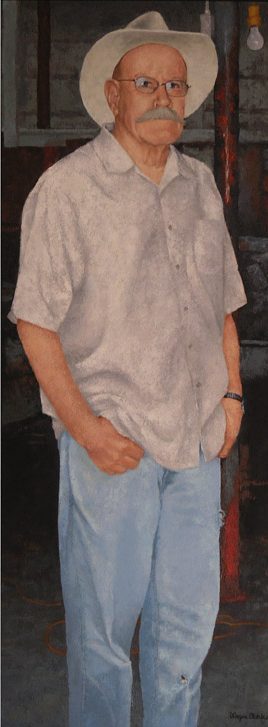Contemporary American Artist
I am a native Kansan, born in Vesper, Kansas in 1926. My life experiences have left me with invaluable references for my paintings and future paintings. With the help of family and friends there is no shortage of subjects, reference material and ideas for paintings.

Wayne Clark, American Painter
By Jane Rogan
Some people know how to live well. They are gifted with a pragmatism that guides them. They choose their life work easily. They do what they were put here to do. No questions asked.
Wayne Clark is this kind of person. Wayne was born in 1926 in Vesper, Kansas. He likes to remind us that Vesper no longer exists, but he does. Upon seeing his work, one instantly knows these paintings are American through and through. One even knows they emanate from the heartland of our country. His pictures are the work of a true American craftsman, a man as honest and straightforward as a farmer or a wood worker. He creates realistic landscapes and portraits that –while amazing the viewer with painstaking technique – do not brag.
When asked about his gift, Wayne is humble. He always liked to draw. He never thought much about being good at it. It was just something he did. As a young boy he drew cartoons to amuse his friends and family, and himself. While serving in WWII, he drew to pass the time in the army barracks and to send letters back to the states. He drew the way some of us pick up a novel.
When Wayne was an illustrator in Kansas during the seventies and eighties, the tremors began to grow slowly in intensity. He was unaware of what might be causing them, and it was not yet interfering with his profession. He consulted doctors in the mid-1990’s, while living in California and still working as a commercial illustrator. Doctors then diagnosed him with “essential tremors,” and told him nothing could be done to alleviate his symptoms. Shortly after he moved back to Kansas in 1999, he was correctly diagnosed with Parkinson’s. At that time he began taking the appropriate medications, (Levodopa). He learned to work with and adapt to the tremors and resume his passion for painting.
Over time, the shaking in his hands increased and a predominant amount of head bobbing began to occur. Wayne never thought to give up painting. Instead he learned to make adjustments in his equipment and technique. He modified his easel through a series of trial and error adaptations, and created a series of permanent maul sticks for the steadying of his hands. He discontinued the use of the palette knife as an application tool [in his earlier work] and moved to the brush. He says he finds the bristles of the brush absorb the shaking from his hands and the head bobbing doesn’t interfere with paint,ing “It’s just a nuisance. As far as drooling, I keep a towel close by until I get a proper fitting bib.”
His wry and pointed humor is as much a part of who he is as his uncanny ability to see and depict fine visual detail. Wayne’s advice for others dealing with Parkinson’s is “adapt.” When pressed for a little for deeper meaning of adapt, the painter paused and said plainly, “don’t be embarrassed.”

